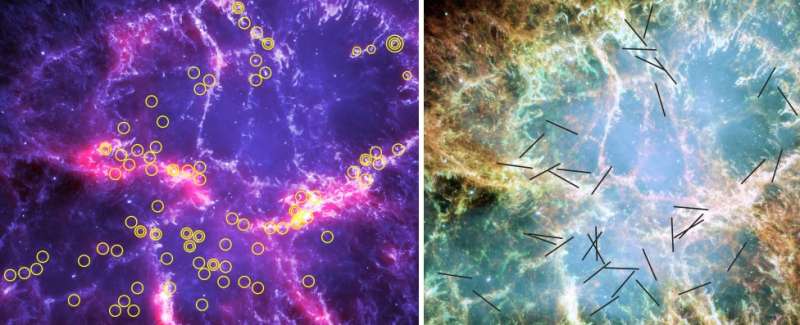November 4, 2016 report
Scientists catalog nearly 100 dusty globules in the Crab Nebula

Researchers from Sweden have recently studied the presence of dust in the Crab Nebula to locate and characterize numerous dusty globules of this well-known supernova remnant. As a result, they have cataloged 92 dusty globules and derived their properties. A paper describing the research was published Oct. 26 on the arXiv pre-print repository.
Located some 6,500 light years away in the constellation of Taurus, the Crab Nebula is a dust-containing supernova remnant that formed after a supernova explosion observed on Earth in 1054. In 1977, the presence of dust in this nebula was detected for the first time. Furthermore, studies conducted in recent decades revealed that the dust is spread over the entire nebula and strongly concentrated to the optical filaments.
Studying dust ejected from supernovae could provide crucial insights on the role it plays in supplying the interstellar medium with dust grains. Moreover, as the origin of dust in supernova remnants is still uncertain, detailed studies of dusty globules could help better understand the process of dust formation.
Recently, a team of scientists led by Tiia Grenman of the Luleå University of Technology in Sweden has analyzed broadband images of the Crab Nebula acquired by the Hubble Space Telescope (HST) between 1994 and 2014. They were looking for dusty clumps like the ones surrounding young stellar clusters.
"The background to this work is our surveys of globulettes in H II regions surrounding young stellar clusters. We were surprised to find similar dusty clumps in the Crab and wondered about similarities and different origins. Rather soon, we found from HST images that the objects were moving with high speed in line with the general expansion of the Crab," said Gösta Gahm of the Stockholm Observatory in Sweden, one of the co-authors of the paper, speaking to Phys.org.
By analyzing the set of HST images, the team managed to locate 92 dusty globules and derived a wealth of data about their properties, including their dimensions, masses, proper motions and distributions.
According to the paper, mean radii of these globules ranges from 400 to 2,000 AU and about 40 percent of the them are slightly elongated with a ratio between major and minor axes higher than 1.5. Their masses vary from one to 58 millionths of the mass of the sun. The researchers found that the globules are distributed over the entire nebula but are less abundant in the region surrounding the central pulsar. They also noted that all the globules move outward from the center along with the general expansion of the remnant.
In conclusion, the scientists try to explain the origin of dust in supernovae. According to the team, the most plausible hypothesis is that the dust is formed in the inner ejecta, the cold remnants of the exploded stellar core, and that grain growth occurs in the remnant at later phases.
"Cold dust in supernova remnants is a hot subject. Remains to be seen how the supernovae community reacts on our results," Gahm said.
The team hopes that further observations of the Crab Nebula, especially with NASA's future James Webb Space Telescope, could provide important new data, including clues to whether the dust is warm or cold.
"Hopefully, the objects can be resolved in the infrared with the coming James Webb Space Telescope," Gahm concluded.
More information: Dusty globules in the Crab Nebula: arxiv.org/pdf/1610.08449.pdf
© 2016 Phys.org


















